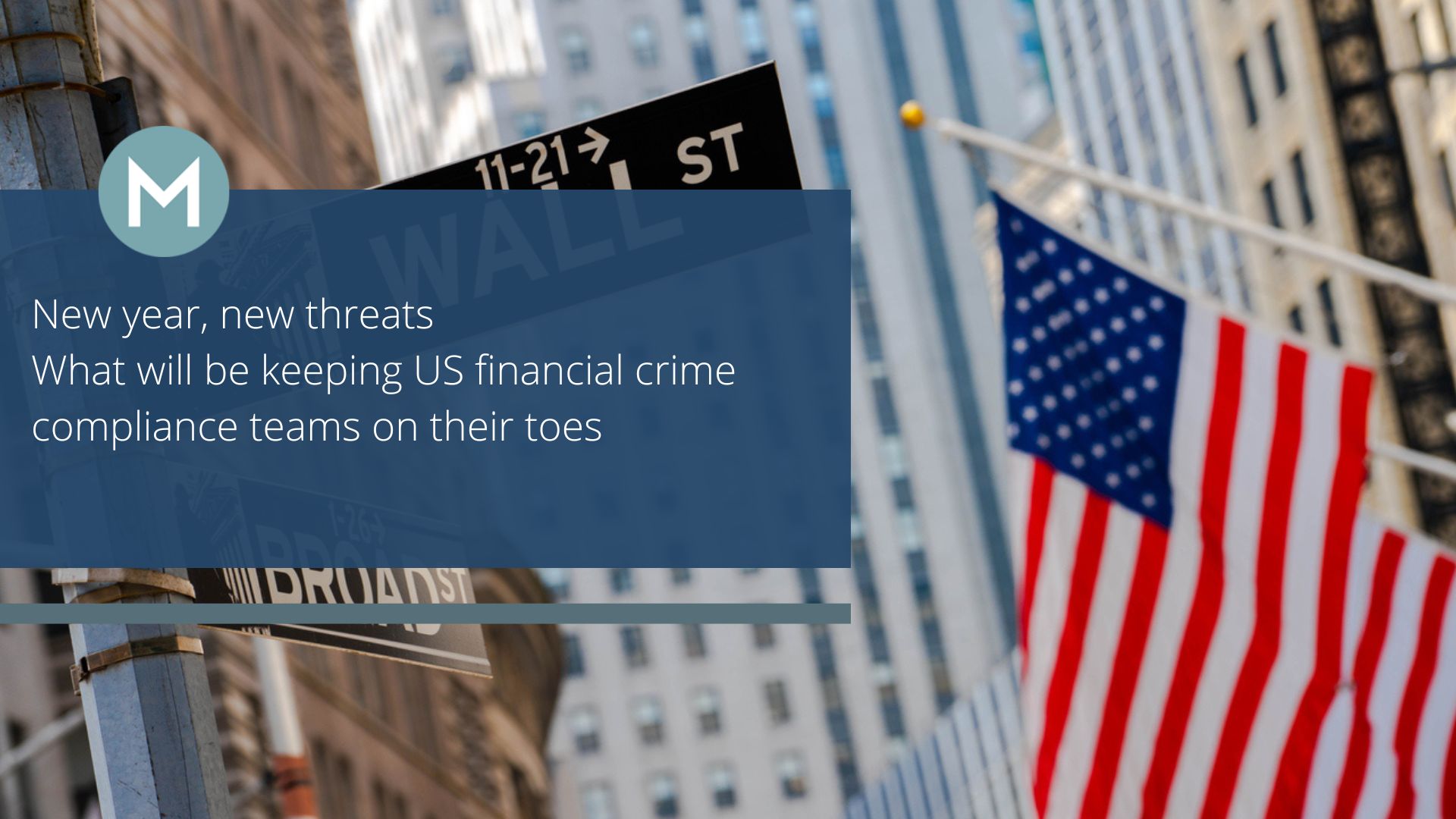New year, new threats – what will be keeping US financial crime compliance teams on their toes.
Financial crime in the US is continuing to be a key concern for Financial Institutions in 2023 as global threats rise and variables including consistent sanctions regimes, new regulatory measures, and harsher penalties for non-compliance will play a vital role in combating new and current threats. In 2023 FI’s must be more adaptable than ever. As we think about financial crime compliance in 2023, here are the key trends, threats, and important areas financial crime compliance teams should be focusing on.
Fraud expected to rise in 2023.
According to PYMTS recent report on, The State of Fraud and Financial Crime in the US, financial crime increased for 62% of all Financial Institutions, and for an even higher percentage of smaller FIs—those with between $5 billion and $25 billion in assets—as well. Additionally, smaller financial institutions were more likely to have seen an increase in the number of fraudulent transactions[1].
Technological adoption has made fraudsters more globally connected, able to travel across borders and time zones, and more adept at exploiting business closing times when employees are most likely offline. Because of this hyperconnectivity, sophisticated fraud rings and con artists may now operate around the clock and commit high levels of fraud. Fraudsters frequently target emerging technology, preying on a lack of laws, weak security, and uninformed customers.
According to conservative industry estimates, at least 10% of all insurance claims include fraud. Consumer insurance prices have been continuously increasing as a result of widespread fraud, which costs insurers an estimated $120 billion yearly in the US alone[2].
The main illegal activity on cryptocurrency exchanges in 2021 was scamming, which attracted criminals due to the technology’s essentially anonymous nature.
Brace yourself for more attacks as online activities increase.
While virtual/remote onboarding has largely improved society by making financial services more accessible, it has also given criminals new opportunities to manipulate the system. The ability to digitally impersonate someone has troubling repercussions with criminals.
Businesses may respond to this increasing threat by making the onboarding process more difficult and by looking for new types of data to identify and authenticate potential clients.
The rise of all-in-one apps has led to billions of people carrying out a significant portion of their mobile activities from a single app, including messaging friends, ordering goods and services, ridesharing, and banking. Super apps, like WeChat and Alipay, are the norm in the East, and this trend is now moving towards the West. Consumers benefit from their ease, but scammers also benefit from them. Criminals can target super applications for account takeovers, to create fake accounts using stolen personal information, to misuse referral systems, and to perpetrate payment fraud if they have a platform to collaborate on and communicate information over [3].
Carbon offset means ESG will need to be a focus for financial crime teams.
In addition to the numerous risk indicators they track, many companies are including environmental, social and governance (ESG) factors into their robust financial crime and anti-bribery & corruption grading systems.
Businesses now assess prospective clients, suppliers, and third parties based on ESG factors in addition to worries about financial crime and ABC risk. Companies with more advanced ESG programmes are aware of the risk of bribery and corruption issues connected to specific sustainability or climate change mitigation activities, including carbon offset programmes.
Bank reputational risk committees should consider ABC and greenwashing concerns while vetting new clients and transactions.
As stated by only 43% and 38% of those polled, respectively, said that ESG metrics were utilised to guarantee adherence to anti-corruption and anti-bribery regulations. Comparatively, 57% of companies in the Asia-Pacific area and 52% in Europe and Latin America had incorporated ESG indicators into their ABC compliance[4].
Will a complicated network of rules and specifications for continuing data verification be provided by the government’s future beneficial owner database? Banks worry that it might
While they wait for the US Treasury Department regulations governing the government’s creation of a database for information on the true, or “beneficial,” owners of legal entities like corporations and trusts, some compliance professionals are worried that they may have an increased workload or even be required to verify the accuracy of data in the registry.
A key source of concern is the potential that banks could eventually be required to verify the accuracy of registry data and would be required to submit SARs where information is unsure. Another is that organisations may be forced to hire more investigators to look into sanction screening systems’, automated notifications if there is a substantial amount of registry data. Treasury’s Financial Crimes Enforcement Network (FinCEN) published a final rule late last month outlining which legal entities will be required to report their beneficial ownership information as of January 1, 2024, in accordance with the Corporate Transparency Act (CTA), a provision of the Anti-Money Laundering Act of 2020. Corporations, limited liability companies, business trusts, and the majority of limited partnerships are among the entities that, with some exceptions, are required to file reports [5].
Crypto compliance
The US central bank has warned that cryptocurrencies pose a “serious” threat to the larger banking system. Risks associated with the cryptocurrency industry must not be permitted to spread to the banking system, according to a joint statement from the Federal Reserve and US regulators, including the Office of the Controller of the Currency, a division of the US Treasury.
Regulators are working hard to develop a system of monitoring for each of the different asset types since risk management of digital assets is becoming more and more crucial. Banks and other financial services firms have a lot to learn as the standards are developed as they get ready for a time when all of these assets will be more crucial to the economy. Fortunately, many risk-management principles that apply to fiat currency also apply to digital assets [6] .
Neo banks & AML
Due to their reliance on quick digital transactions, neo banks are at risk from financial crime. Neo banks are required to implement a number of safeguards to avoid aiding in unlawful activities like money laundering, financing terrorism, corruption, bribery, and fraud. As a result, regulatory agencies treated neo banks the same as other financial service providers. Neo banks should take action to protect AML compliance and thwart financial crimes without compromising their daily business operations.
The right talent deal with the complexity of compliance and new age threats
It is clear to see that from the upcoming trends, fighting financial crime will require additional skilled resources, which is why the future of resilient financial crime fighting will rely on the contingent workforce.
With new trends in hiring and retaining key talent, more organisations are turning to the contingent workforce model to help them deliver on critical projects, deal with surges in work, and get back to business as usual. The contingent workforce tackles the significant challenge of rapid and cost-effective staffing without the need for lengthy and time-consuming selection processes, interviews, or onboarding. This is also seen in the utilisation of offshore contingent models to access key talent that would otherwise be difficult to find locally.
Most firms’ permanent recruitment procedures are slow in a fast-paced market. Recruiting good, competent people can take months, which is why there has been such a high demand for skilled compliance contingent professionals in 2022, and this is expected to rise in 2023.
The pandemic created a new era of talent and recruitment with many firms struggling to resume BAU as additional regulatory and risk compliance requirements are placed on their already thin stretched teams.
Utilising the expertise of contingent resourcing can offer many firms breathing space in terms of resolving any issues their AML controls may have. Setting up the right teams to ensure any gaps are identified will be key for firms in 2023 and into the coming years, as regulators place more pressure on financial service participants to strengthen current compliance systems and controls.
Works cited:
[1] “The State of Fraud and Financial Crime in the U.S.” Featurespace, Sept. 2022, www.featurespace.com/the-state-of-fincrime-in-the-us-2022-report/. Accessed 12 Nov. 2022.
[2] “Background On: Insurance Fraud | III.” Iii.org, 2019, www.iii.org/article/background-on-insurance-fraud. Accessed 8 Dec. 2022.
[3]“Financial Crime Trends to Watch in 2023.” Financial IT, 2 Dec. 2022, financialit.net/news/security/financial-crime-trends-watch-2023. Accessed 8 Dec. 2022.
[4] “Wolcott, Rachel. “Corporations Add ESG to Financial Crime Risk Screens as Bribery & Corruption Risk Surface in Carbon Offset Schemes.” Thomson Reuters Institute, 25 Aug. 2022, www.thomsonreuters.com/en-us/posts/investigation-fraud-and-risk/esg-financial-crime-risk-screens/. Accessed 8 Dec. 2022.
[5]“Greggwirth. “Bankers Concerned US Beneficial Ownership Database Will Add to Compliance Burden.” Thomson Reuters Institute, 14 Nov. 2022, www.thomsonreuters.com/en-us/posts/investigation-fraud-and-risk/beneficial-ownership-database-concerns/. Accessed 8 Dec. 2022.
[6] “Hobbs, Bill, and Steven Beattie. “Adapting to Digital Assets and Cryptocurrencies.” Www.ey.com, 18 Oct. 2022, www.ey.com/en_us/financial-services/what-financial-services-boards-can-do-to-prepare-for-digital-assets. Accessed 8 Dec. 2022.

